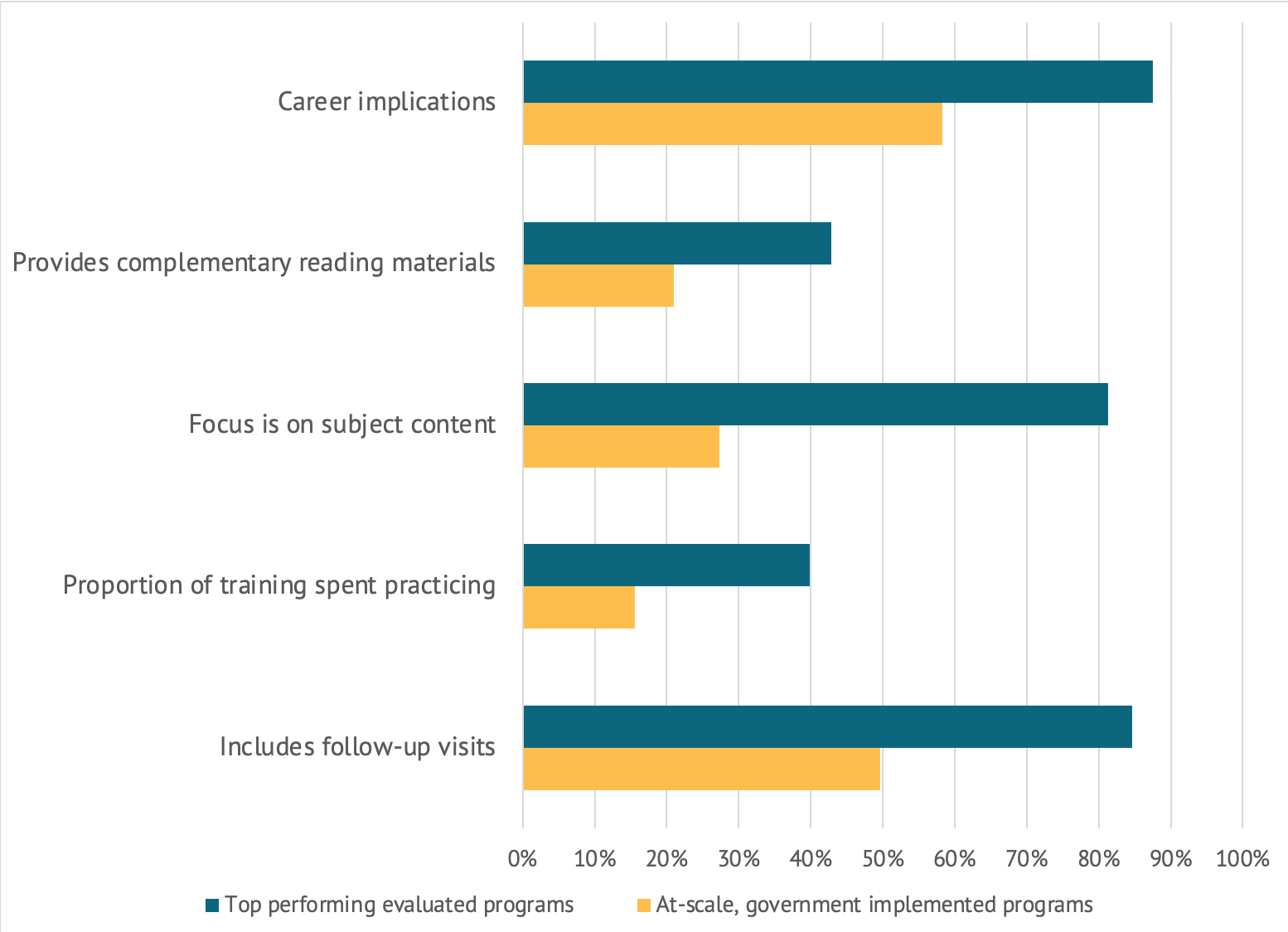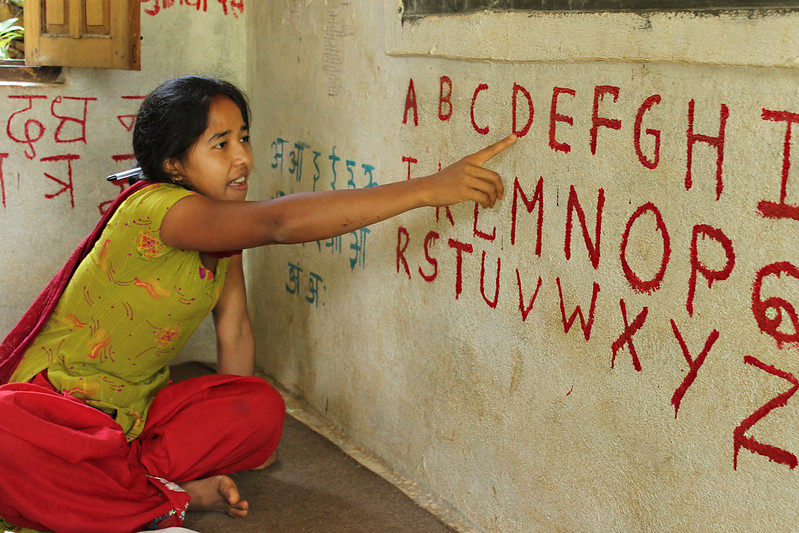Recommended
While learners are at the heart of education, teachers are the main veins carrying blood to that heart. At the recent Comparative and International Education Society conference, I shared ten things—six I know and four I want to know—about supporting teachers to end the global learning crisis.
Six Things I Know about Teachers *
1. There is no replacement for teachers. As Linda Darling-Hammond put it, “Teaching is the profession upon which all other professions depend.” When we look at the interventions that many look to for improving learning outcomes in low- and middle-income countries, two that come up repeatedly (including in the recent “Smart Buys” report on improving learning) are (a) “structured pedagogy” programs (with structured lesson plans for teachers, student books, and lots of teacher coaching), tested in Kenya and the Gambia and (b) interventions that help teachers (and teachers’ assistants) to target their instruction to students’ current learning levels, tested in Ghana and India. Both of these programs work through teachers! We also know that teachers are essential for helping students develop skills that don’t show up in tests, like hard work and tenacity.
2. With rising numbers in the student-age population, we will need many, many more teachers in the years to come. In many countries, young populations are still growing AND enrollment rates are rising. In South Africa, a recent report suggests that those dynamics combine with an upcoming wave of teacher retirements to mean that by 2030, “the annual production of Grade 1 to 12 teachers would need to” double! Mendez Acosta and I have been working on projections for other countries in the region. Early estimates suggest that many countries will see an increase of at least 50 percent in the number of primary school students in the next twenty years. With a need for many more teachers in the years to come, we’ll need to provide them with a lot more support.
3. Education systems have lots of entry points to strengthen the teacher workforce. Education systems can attract more skilled, motivated candidates to enter teaching, as South Africa and Chile have done with getting good students into teaching math and science. They can also train them better, recruit and select who actually enters the teaching workforce more strategically, provide more effective professional development for working teachers, deploy teachers more wisely, and provide poorly performing teachers with both support and accountability. There are a lot of policy levers, and we have at least some evidence of effective interventions on all of them.
4. Highly practical teacher professional development and support can be effective. In a review of teacher professional development programs around the world, Popova and others found that programs that give teachers lots of time to practice with other teachers lead to larger learning gains. In high and middle-income countries, coaching—following a teacher into her classroom and giving her practical feedback—has consistently delivered gains on student learning. While those gains tend to be smaller when the programs are implemented at large scale, they’re still substantive. Furthermore, we have evidence of positive impacts from a national teacher coaching program in Peru. From South Africa, we see that at least some of the impact of coaching on student learning can endure after the coaching ends.
5. Meritocratic teacher hiring can boost student learning. Countries have a patchwork of policies to hire teachers—in some places, teachers pay bribes to get hired. In other places, there’s not necessarily corruption but just weak, unsystematic policies. We have evidence that using exams (among other elements) to incorporate teacher knowledge into hiring (in Mexico and in Colombia) are associated with higher student learning. (Exams aren’t always great predictors of teacher skill in and of themselves, but using them as a screening tool can discourage some of the worst candidates.)
6. Technology is an important but dangerous tool. People have been trying to use technology to replace teachers for many years, and I’ve never seen a good example. There are many examples of using technology to complement teaching: integrating videos into classes in Pakistan, Ghana, India, Mexico, and elsewhere. But at least as often, I’ve seen education systems with eyes larger than their stomachs, investing in technology beyond the infrastructure’s capacity to support. School closures during COVID provided further evidence that ed-tech is no substitute for a teacher. Education systems will continue to invest in technology; but caution is consistently warranted.
Four things I still want to know
1. What are the best ways to prioritize, at a system-specific level, opportunities to strengthen the teacher workforce? With all the entry points to improve teacher policy—attracting, training, recruiting, supporting—it can be overwhelming to figure out which entry points will deliver the biggest gains in a given system. It’s easy to compile a laundry list of all the challenges that teachers face; it’s harder to determine which should be the first priorities to rectify. Existing diagnostic tools like the constraints-to-growth analysis to decide what’s holding countries back from economic growth or the RISE education systems diagnostic to determine what education systems need could provide inspiration for identifying the most immediate obstacles to teacher performance—and the areas that need longer term investment.
2. How can education systems best implement coaching at scale, especially in environments with small budgets? We know that coaching is an integral part of effective teacher professional development. And while we’ve seen some evidence of effective implementation at scale in an upper middle-income country (Peru) and as one ingredient in a broader learning program in at least a couple of lower middle-income countries (India and Kenya), figuring out how to do this in low-income countries with fewer potential high-quality coaches, fewer resources for transport (given the evidence on virtual coaching so far), and in remote areas is still a work in progress.
3. Teacher accountability comes in many forms. How effective are programs that aren’t pay-for-performance? A lot of pay-for-performance programs have been evaluated in low- and middle-income countries; only a minority have been scaled or sustained, mostly as pilots. But accountability comes in many more forms than just paying teachers for test scores or attendance: peer observation, school principal observation, public reporting of schoolwide test results, school coverage in local news media, and coaching all add accountability. These forms of professional accountability matter a lot of people across many fields; I’d like to see more evidence on how they change learning outcomes.
4. How do we move from a low professionalism equilibrium to a high professionalism equilibrium? The World Development Report 2018 expressed that many countries are trapped in a “low-learning equilibrium.” Likewise, many countries are trapped in a low equilibrium when it comes to teacher professionalism—where teachers are poorly trained, unsystematically recruited, unsupported, not held accountable, and not respected. Other countries are in a high teacher professionalism equilibrium. I worry that small, individual changes from a low professionalism equilibrium may not achieve what we hope: introducing accountability without support or introducing better pre-service without better recruitment may not change how teachers see themselves and who is drawn to the profession. Yet no education system has the resources (financial or human) to transform the teaching profession in short order. So charting the path to an equilibrium of high professionalism remains challenging.
There are interventions with evidence to back them that boost teacher performance and student learning. Even as we continue to learn, we can act on the evidence we have to leverage this most important resource to mitigate the global learning crisis.
* I’m a researcher, so “things I know” is actually code for the considerably less pithy “things I’m reasonably confident about.”
Disclaimer
CGD blog posts reflect the views of the authors, drawing on prior research and experience in their areas of expertise. CGD is a nonpartisan, independent organization and does not take institutional positions.
Image credit for social media/web: Adobe Stock







